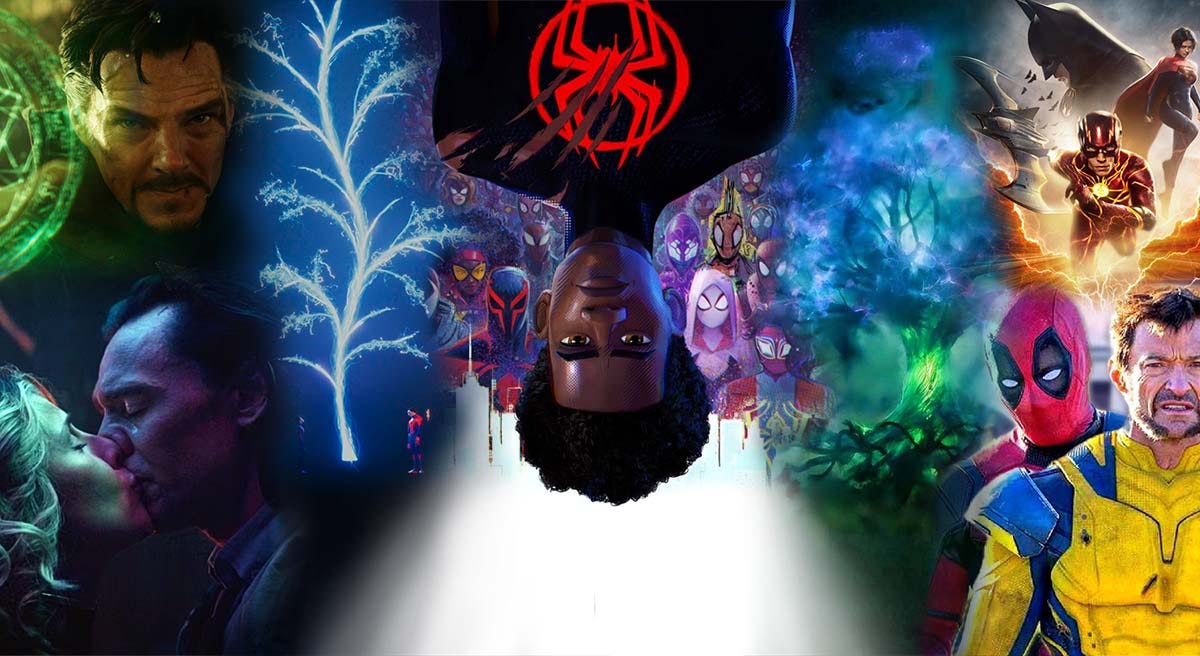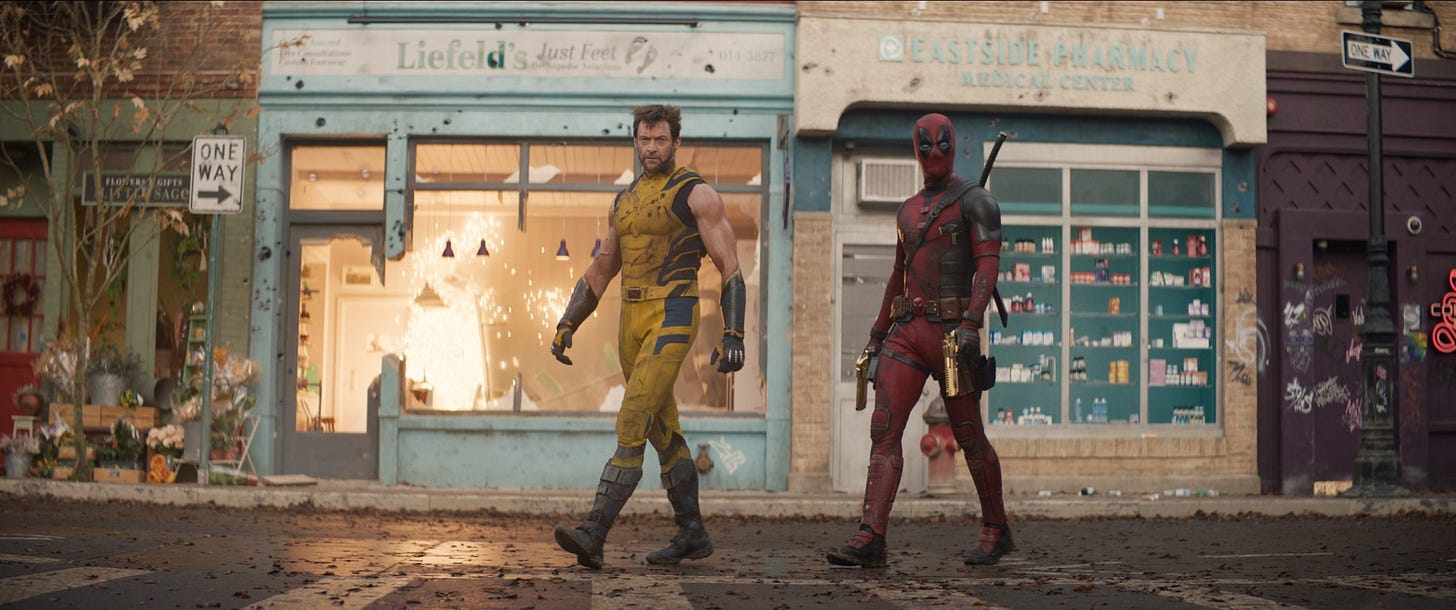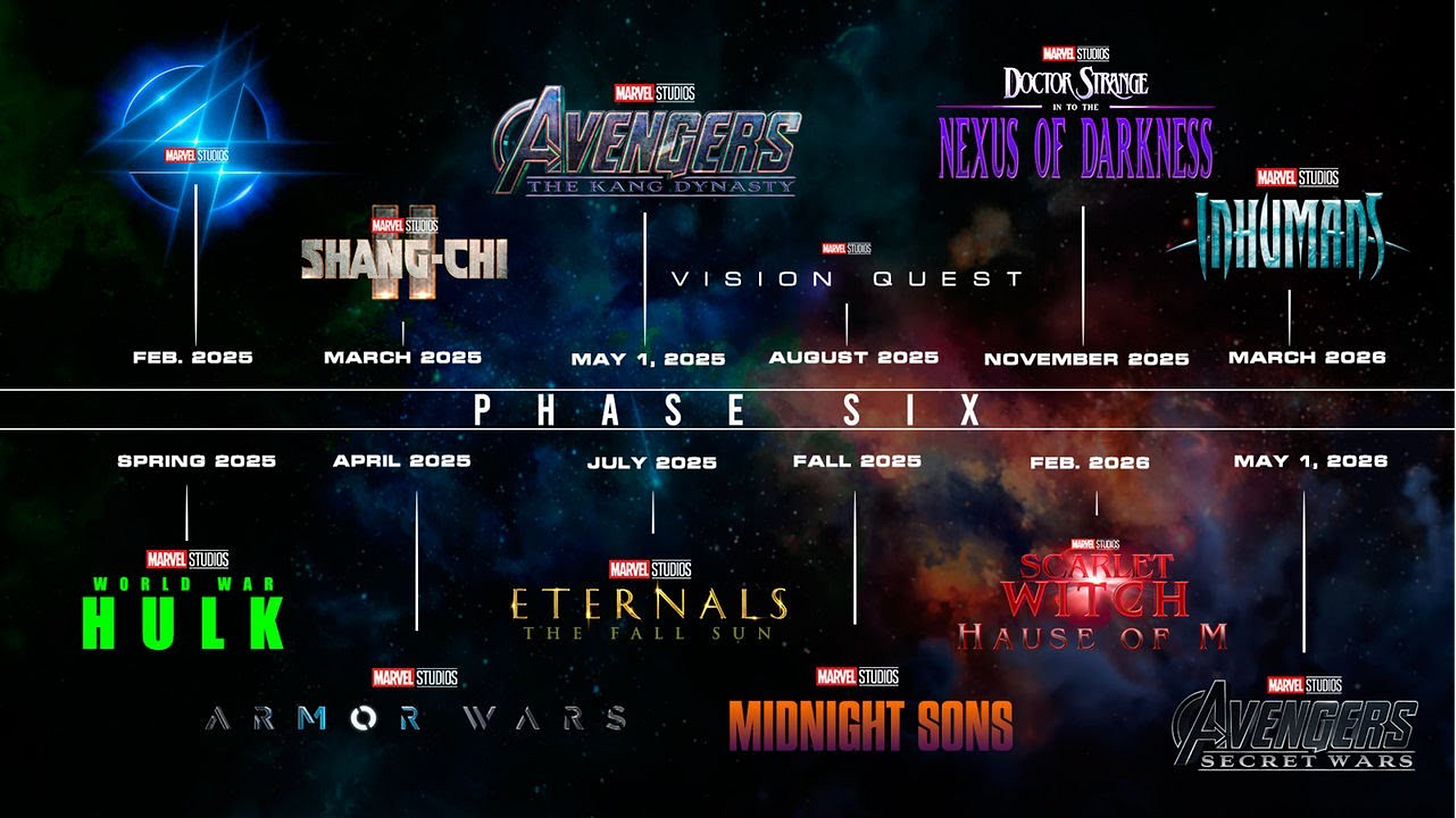Crisis of meaning on infinite earths, part 1: The multiverse and superhero movies
[LONGREAD: how we got here: comic books, caped crusaders, alternate realities…and the meaning of life]
Part 1 | Part 2 | Part 3 | Part 4 | more to come…
“The Multiverse Idea Is Rotting Culture,” Sam Kriss argued in The Atlantic all the way back in 2016. That was long before the Marvel Cinematic Universe’s massive “Multiverse Saga” even started to unfold, although the groundwork was laid that same year in Scott Derrickson’s Doctor Strange. Two years later, the creative and popular triumph of the animated Spider-Man: Into the Spider-Verse offered a powerful counter-argument to Kriss’s thesis—and multiverse storytelling continued to expand with no end in sight.
Note: “Multiverses and Alternate Realities: Other Worlds in Film” is the name of a seminar in which I participated last September at Gonzaga University in Spokane, Washington. The latest in the annual “Faith, Film, Philosophy” series from Gonzaga’s Faith and Reason Institute, the seminar looked at the extraordinary ascendancy in recent years of multiverse and alternate-reality storytelling in popular culture—an expansive phenomenon embracing everything from the 2023 Oscar favorite Everything Everywhere All at Once and the Marvel Cinematic Universe juggernaut to TV series like Rick & Morty, The Umbrella Academy, and Stranger Things, among many other examples. This essay series is based on my presentation.
Others have carried Kriss’s concerns forward, arguing that multiverse stories are boring and calling the multiverse “where originality goes to die.” Meanwhile, among many other things, Tom Hiddleston’s god of mischief (or one variant of him, among many others) charmed viewers on two seasons of the Disney+ series Loki; the crowd-pleasing 2023 Oscar favorite Everything Everywhere All At Once took direct aim at some of the arguments against multiversal storytelling; and a second excursion into the Spider-Verse proved as ambitious and thrilling as the first. Looking ahead, the upcoming Deadpool & Wolverine is the latest reminder that the multiverse is still very much with us.
At this point, though, we may be living through the slow bursting of the multiverse bubble—a pop-culture big crunch that, for some, can’t arrive too soon. The vanguard of the phenomenon, the MCU, has been slipping awhile both creatively and popularly (a decline not helped by domestic violence convictions against Jonathan Majors, whose character Kang the Conqueror was slated to become the main heavy in the Multiverse Saga). Loki got a second season, but there are no plans for a third. DC’s Extended Universe was late to the multiverse party with last year’s box-office bomb The Flash; if last year’s Aquaman sequel didn’t need the multiverse to mark the death knell of the DCEU, it’s still one multiverse we won’t be seeing more of.
Is this finally at least the beginning of the end of the multiverse?
Critics vs. the multiverse!
Multiverse controversy extends far beyond pop-culture concerns about creative, compelling storytelling. In the scientific community, multiverse hypotheses (or speculation) have been criticized as unscientific, belittled as “religion,” and even condemned as immoral—for proposing immense cosmological concepts that can be neither verified nor falsified. (Other scientists disagree, obviously.)
Another type of resistance comes from religious philosophers and apologists attached to arguments for God’s existence based on the concept of cosmological fine tuning or anthropic coincidences. Apologetically speaking, multiverse hypotheses may appear as a nonbeliever’s cosmological Hail Mary play casting our just-right universe as a statistically inevitable winner in a multiversal lottery, much like our just-right planet Earth in a visible universe of 10 million billion billion planets. (Again, other apologists see it differently.)
A third kind of objection is raised by a certain type of moralist who considers the multiverse concept to be debilitating to moral thinking, or even antithetical to morality itself. For example, if everything that can happen does happen—say, if Hitler always loses and always wins an infinite number of times in an infinite number of worlds—then it might understandably be wondered just how pressing anyone’s duty really is to suffer and sacrifice in the struggle against the Nazis.
This last concern is, of course, the one most directly relevant to multiverse storytelling: Is it possible to tell meaningful stories in a multiverse premise? Or does the multiverse idea tend toward nihilism? While this question is obviously much bigger than superhero storytelling (in particular, Everything Everywhere All at Once confronted this question head-on), in this series of essays I’m primarily concerned with the two biggest venues of ongoing multiverse storytelling, the MCU and the Spider-Verse.
First, some back story…
A comic-book history of the multiverse
The earliest comic-book superheroes appeared in solo adventures isolated from one another. These included Superman, Batman, and Wonder Woman from the company today known as DC, and Captain America, Namor the Sub-Mariner, and the original Human Torch from the company that came to be Marvel Comics. Superhero crossovers establishing the concept of a superhero shared universe began as early as 1939 with the Sub-Mariner battling the Human Torch. Before long DC introduced the Justice Society of America, Superman/Batman crossovers, and so forth.
Then it happened: In 1953, a pioneering story transported Wonder Woman to what she called a “twin world, existing simultaneously alongside” Earth, where everyone “is a double of everyone on Earth”—including, of course, a double of Wonder Woman herself. In this early story of two Wonder Women, the idea of a parallel world was an imaginative one-off conceit, like the later “Mirror, Mirror” episode of the original Star Trek series. By the 1960s, though, DC Comics was motivated to incorporate multiversal concepts more rigorously into their ongoing storytelling.
The reason was rooted in a substantial revolution in the world of comics beginning in the mid-1950s: What comics historians retroactively dubbed the Golden Age of comics ended, and the Silver Age began. At Marvel Comics there was a huge leap forward with the introduction of the Fantastic Four, Spider-Man, the Avengers, the X-Men, and more, as well as the return of Captain America. The transition at DC was more uneven. There were new heroes from Supergirl and Batgirl to Martian Manhunter, new incarnations of the Flash and Green Lantern, and a Justice League instead of a Justice Society. Superman became vastly more powerful, while Batman lost his dark edge and crimefighting milieu, becoming a cheerful do-gooder as close in spirit to the more successful Superman as possible.
It was perhaps partly because of DC’s uneven execution that eventually nostalgia for the older DC stories led to a new kind of crossover adventure, with the new Silver Age heroes—beginning with the new Flash in a groundbreaking 1961 adventure—encountering their Golden Age predecessors, now revealed to be living on an alternate Earth. Somewhat counterintuitively, the world of the new Silver Age heroes (being the main DC continuity at the time) became known as Earth-One, while the world of the original Golden Age heroes was retroactively designated Earth-Two.
In time DC unveiled additional worlds: Earth-Three (a sort of dark mirror universe where the DC heroes were supervillains—so much for Wonder Woman’s theory about evil always being challenged by a Wonder Woman on every world), Earth-X (where the Nazis won World War II), Earth-C and C-minus (funny-animal worlds with funny-animal superheroes), and many others. On occasion DC acquired rights to characters from other comic-book publishers (like Fawcett Comics, the original publishers of the original Captain Marvel—the one who says “Shazam!” and is now called that)—and the separate worlds of these new acquisitions were merrily folded into the ever-expanding, increasingly haphazard and convoluted DC multiverse.
Marvel took longer to embrace the multiverse concept. In 1962 the new Human Torch (the one from the Fantastic Four) visited a bizarre realm called the “Fifth Dimension” where, much later—in 1975—the Fantastic Four met alternate versions of themselves from another timeline, a first for Marvel. Finally in 1977 Marvel debuted What If?, a title devoted to exploring alternate worlds where events departed from mainstream Marvel continuity.
In the mid-1980s, at the end of what has come to be called the Bronze Age of comics, something significant happened. DC Comics, under various cultural and economic pressures, undertook a second massive reboot project—this time in a diegetic or narrative crossover event designed to greatly simplify, streamline, and modernize the unwieldy DC multiverse into a single continuity. This daring experiment, called Crisis on Infinite Earths, revitalized DC Comics and paved the way for new interpretations of the classic heroes inspired by the best of the Golden, Silver, and Bronze Ages. The Modern Age of comics was underway.
Multiverses of madness on the big screen?
Are we at a similar “crisis” point in the evolution of live-action superhero storytelling?
As in the comics, superheroes on the screen originally starred in solo adventures, with DC heavy hitters Superman and Batman appearing in various incarnations on the big and small screens throughout the 20th century, along with the small-screen adventures of Wonder Woman, the Hulk, and Spider-Man. The 1980s saw a few lowkey overlaps; the 1984 Supergirl movie is glancingly connected to the Christopher Reeve Superman films, and the small-screen Hulk franchise included made-for-TV movies guest-starring incarnations of Thor and Daredevil. Big-screen Marvel adaptations began in earnest starting in 2000 with the X-Men movies and Sam Raimi’s Spider-Man trilogy, among others.
Finally, in 2008, the shared Marvel Cinematic Universe (MCU) franchise arrived in a momentous post-credits sequence in Iron Man featuring Samuel L. Jackson’s Nick Fury teasing “the Avenger initiative.” Much like early Marvel and DC comics, Iron Man was followed by mostly self-contained stories featuring the Hulk, Thor, and Captain America, building to the unprecedented big-screen shared-universe event that was Joss Whedon’s 2012 The Avengers. Since then, crossovers have become common, and the sprawling first three “Phases” of the MCU, also known as the Infinity Saga, built to a cosmic struggle pitting Josh Brolin’s genocidal Thanos against pretty much everyone, stretching the world of MCU storytelling about as far as it could go—at least, in one universe, more or less.
So now, for Phases Four, Five, and Six, the MCU gives us the Multiverse Saga in progress. Attractions include a nostalgic example, in the third MCU Spider-Man movie, 2021’s No Way Home, of the current version of a hero, Tom Holland’s Spider-Man, meeting prior versions of himself played by Tobey Maguire and Andrew Garfield, just like Earth-One and Earth-Two in DC’s Silver Age. Earlier this year we saw the same thing from DC in the financially disastrous Flash movie, which brought back no less than Michael Keaton as Old Batman and George Clooney as Really Well-Preserved Batman, along with queasy, digitally fudged post-mortem cameos including Christopher Reeve, George Reeves, and Adam West.
More significantly, in Kang the Conqueror—a variant of whom was first introduced in Loki going by the handle He Who Remains—the MCU has a villain the scale of whose nihilistic scope of action is exponentially beyond that of Thanos. After all, Thanos merely wiped out half the lives in a single universe. Kang’s designs are unfathomable orders of magnitude beyond that. The big question, of course, is: Is this multiversal escalation a narrative solution or a new narratological problem? Is the multiverse version of the MCU, like pre-Crisis DC, simply becoming too convoluted and too expansive to care about? Will the MCU eventually need a streamlining Crisis on Infinite Earths–type event?
These are complex questions. On the one hand, as I’ll argue in this series, I do think there’s a sense in which, the more we learn about the MCU, the more nihilistic a place it seems. On the other hand, I’m not convinced that this is intrinsic to multiverse storytelling—which, of course, is another way of saying that I’m not convinced that multiverse hypotheses are debilitating to moral thinking in reality. I’m not convinced that resistance to the multiverse concept from either a scientific or an apologetical perspective is necessary or warranted. I think we should be open-minded about multiverse hypotheses in the real world, and a fortiori we should be open-minded about them in fiction.
But first, let’s take a closer look at the MCU Multiverse and the Spider-Verse, and specifically at the implications of the interdimensional agencies that claim to protect the multiverse: the Time Variance Authority (or TVA) and the Spider-Society!











If you asked C.S. Lewis if Aslan was Jesus, he would say "no". If you asked Lucy Pevensie if Aslan was Jesus, what would she say? Lewis would say "no" for the simple reason that Aslan is fiction and Jesus is not. The thing about MCU "in-world" or "in-universe" events is that they are fiction. There is no world to be in, there is no universe to be in, and there is no multi-verse to be in. In the Last Battle, Lewis suggests that "London" and "Narnia" are both related in that they are Shadow-land imitations of Aslan's Country, but again Lewis would tell you that both the London and the Narnia he is talking about are fiction. In Part 3 you talk about what might happen in Spider-verse 3 based on what you know about the creatives who made it. in Part 4 you seem to be talking about the MCU as if it were somehow not made by movie makers. Perhaps I am missing something important here and I have misunderstood you, but perhaps the meaning of life for movie characters or comic book characters is meaningless and arbitrary, it may not follow that real life is also. Writers and artists and filmmakers put something of themselves into their work and in that we can learn about them and, perhaps ourselves, but they do not really create a new world every time they set pen to paper. Perhaps what I can learn from Marvel movies is my own occasional fear that perhaps God doesn't really love me is one shared by others. As a Shakespeare might say: "Life's but a walking shadow, a poor player,
That struts and frets his hour upon the stage,
And then is heard no more. It is a tale
Told by an idiot, full of sound and fury,
Signifying nothing." (But this is not new to the MCU.)
I loved reading this and I'm really looking forward to more. However, I can't help but question why you are writing this now instead of waiting until the MCU's Multiverse Saga is over (or at least until you see the third Spider-Verse installment).